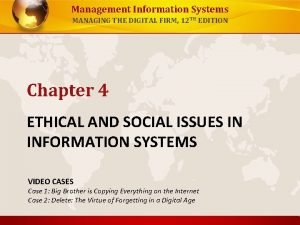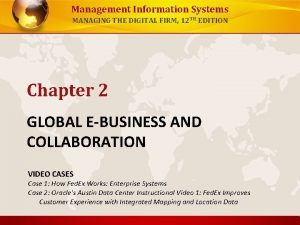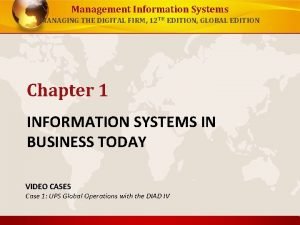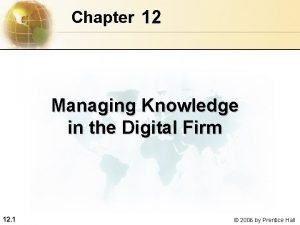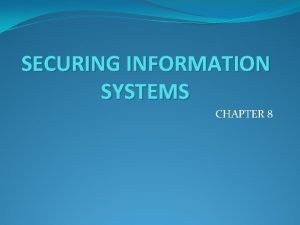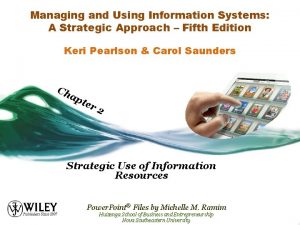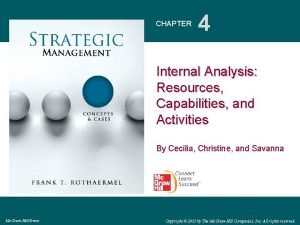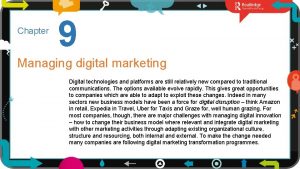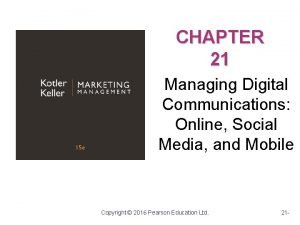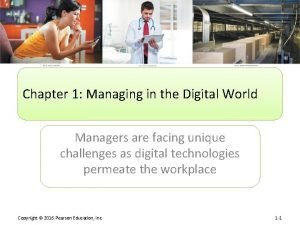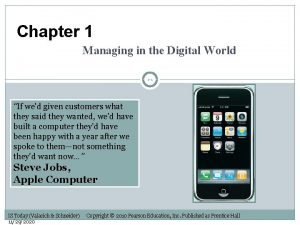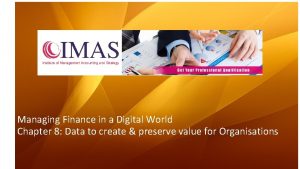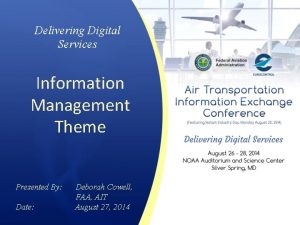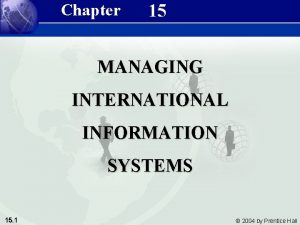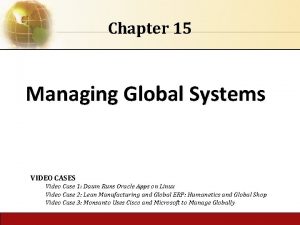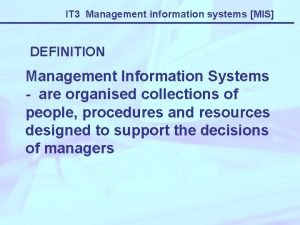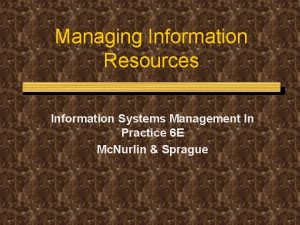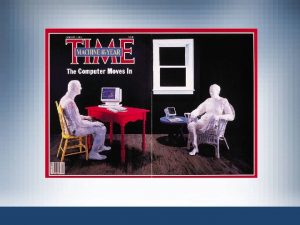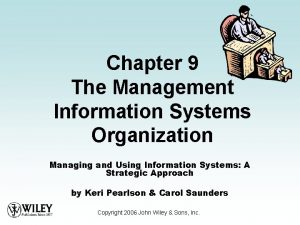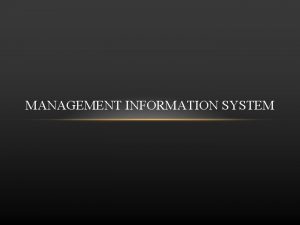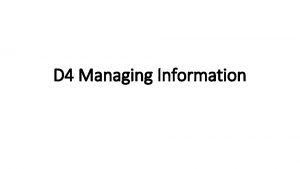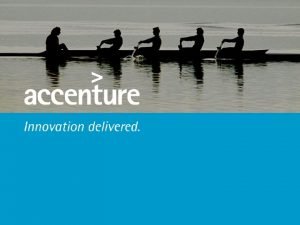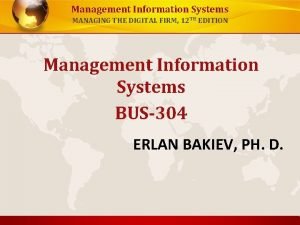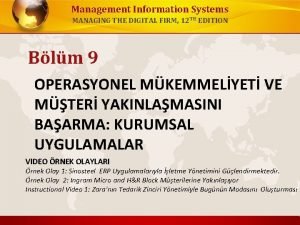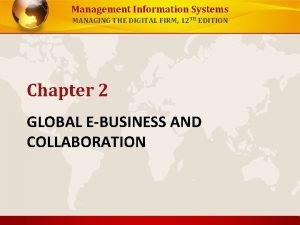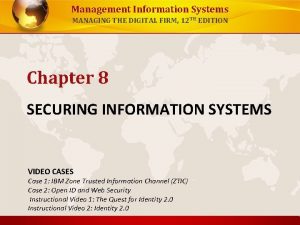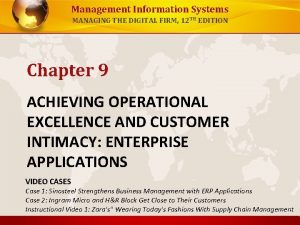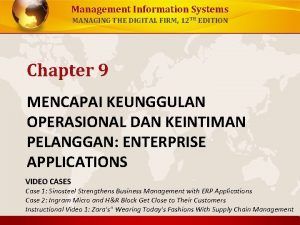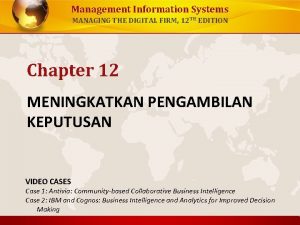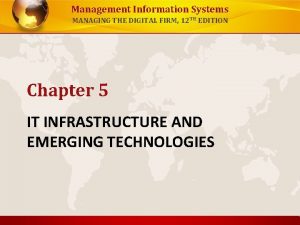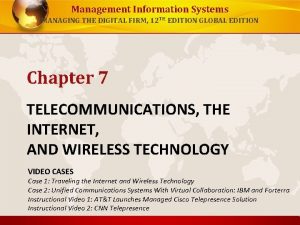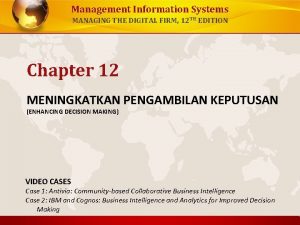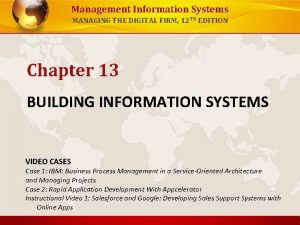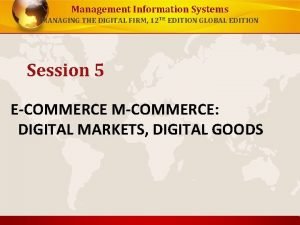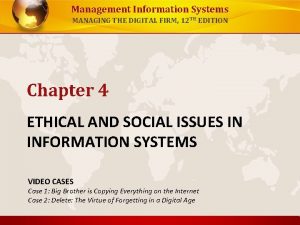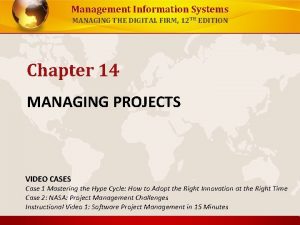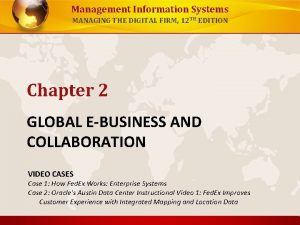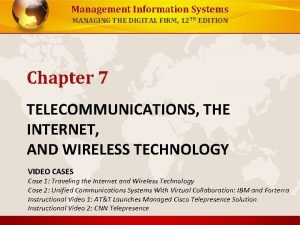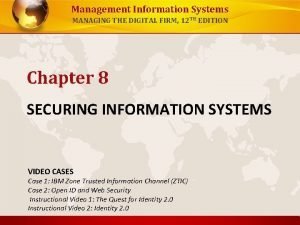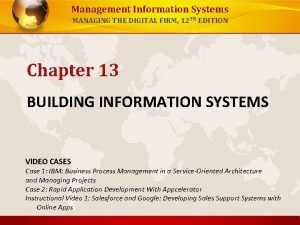Management Information Systems MANAGING THE DIGITAL FIRM 12



































- Slides: 35

Management Information Systems MANAGING THE DIGITAL FIRM, 12 TH EDITION Chapter 2 GLOBAL E-BUSINESS AND COLLABORATION VIDEO CASES Case 1: How Fed. Ex Works: Enterprise Systems Case 2: Oracle's Austin Data Center Instructional Video 1: Fed. Ex Improves Customer Experience with Integrated Mapping and Location Data

Management Information Systems CHAPTER 2: GLOBAL E-BUSINESS AND COLLABORATION Business Processes and Information Systems • Business processes: – Workflows of material, information, knowledge – Sets of activities, steps – May be tied to functional area or be crossfunctional • Businesses: Can be seen as collection of business processes • Business processes may be assets or liabilities 2 © Prentice Hall 2011

Management Information Systems CHAPTER 2: GLOBAL E-BUSINESS AND COLLABORATION Business Processes and Information Systems • Examples of functional business processes – Manufacturing and production • Assembling the product – Sales and marketing • Identifying customers – Finance and accounting • Creating financial statements – Human resources • Hiring employees 3 © Prentice Hall 2011

Management Information Systems CHAPTER 2: GLOBAL E-BUSINESS AND COLLABORATION Business Processes and Information Systems The Order Fulfillment Process FIGURE 2 -1 4 Fulfilling a customer order involves a complex set of steps that requires the close coordination of the sales, accounting, and manufacturing functions. © Prentice Hall 2011

Management Information Systems CHAPTER 2: GLOBAL E-BUSINESS AND COLLABORATION Business Processes and Information Systems • Information technology enhances business processes in two main ways: 1. Increasing efficiency of existing processes • Automating steps that were manual 2. Enabling entirely new processes that are capable of transforming the businesses • Change flow of information • Replace sequential steps with parallel steps • Eliminate delays in decision making 5 © Prentice Hall 2011

Management Information Systems CHAPTER 2: GLOBAL E-BUSINESS AND COLLABORATION Types of Information Systems • Transaction processing systems – Perform and record daily routine transactions necessary to conduct business • Examples: sales order entry, payroll, shipping – Allow managers to monitor status of operations and relations with external environment – Serve operational levels – Serve predefined, structured goals and decision making 6 © Prentice Hall 2011

Management Information Systems CHAPTER 2: GLOBAL E-BUSINESS AND COLLABORATION Types of Information Systems A Payroll TPS A TPS for payroll processing captures employee payment transaction data (such as a time card). System outputs include online and hard-copy reports for management and employee paychecks. FIGURE 2 -2 7 © Prentice Hall 2011

Management Information Systems CHAPTER 2: GLOBAL E-BUSINESS AND COLLABORATION Types of Information Systems • Management information systems – Serve middle management – Provide reports on firm’s current performance, based on data from TPS – Provide answers to routine questions with predefined procedure for answering them – Typically have little analytic capability 8 © Prentice Hall 2011

Management Information Systems CHAPTER 2: GLOBAL E-BUSINESS AND COLLABORATION Types of Information Systems How Management Information Systems Obtain Their Data from the Organization’s TPS FIGURE 2 -3 9 In the system illustrated by this diagram, three TPS supply summarized transaction data to the MIS reporting system at the end of the time period. Managers gain access to the organizational data through the MIS, which provides them with the appropriate reports. © Prentice Hall 2011

Management Information Systems CHAPTER 2: GLOBAL E-BUSINESS AND COLLABORATION Types of Information Systems Sample MIS Report FIGURE 2 -4 10 This report, showing summarized annual sales data, was produced by the MIS in Figure 2 -3. © Prentice Hall 2011

Management Information Systems CHAPTER 2: GLOBAL E-BUSINESS AND COLLABORATION Types of Information Systems • Decision support systems – Serve middle management – Support non-routine decision making • Example: What is impact on production schedule if December sales doubled? – Often use external information as well from TPS and MIS – Model driven DSS • Voyage-estimating systems – Data driven DSS • Intrawest’s marketing analysis systems 11 © Prentice Hall 2011

Management Information Systems CHAPTER 2: GLOBAL E-BUSINESS AND COLLABORATION Types of Information Systems Voyage-Estimating Decision Support System FIGURE 2 -5 12 This DSS operates on a powerful PC. It is used daily by managers who must develop bids on shipping contracts. © Prentice Hall 2011

Management Information Systems CHAPTER 2: GLOBAL E-BUSINESS AND COLLABORATION Types of Information Systems • Business intelligence – Class of software applications – Analyze current and historical data to find patterns and trends and aid decision-making – Used in systems that support middle and senior management • Data-driven DSS • Executive support systems (ESS) 13 © Prentice Hall 2011

Management Information Systems CHAPTER 2: GLOBAL E-BUSINESS AND COLLABORATION Types of Information Systems • Executive support systems – Support senior management – Address non-routine decisions • Requiring judgment, evaluation, and insight – Incorporate data about external events (e. g. new tax laws or competitors) as well as summarized information from internal MIS and DSS – Example: Digital dashboard with real-time view of firm’s financial performance: working capital, accounts receivable, accounts payable, cash flow, and inventory 14 © Prentice Hall 2011

Management Information Systems CHAPTER 2: GLOBAL E-BUSINESS AND COLLABORATION Types of Information Systems • Systems from a constituency perspective – Transaction processing systems: supporting operational level employees – Management information systems and decision-support systems: supporting managers – Executive support systems: supporting executives 15 © Prentice Hall 2011

Management Information Systems CHAPTER 2: GLOBAL E-BUSINESS AND COLLABORATION Types of Information Systems • Relationship of systems to one another – TPS: Major source of data for other systems – ESS: Recipient of data from lower-level systems – Data may be exchanged between systems – In reality, most businesses’ systems are only loosely integrated (but they are getting better!) 16 © Prentice Hall 2011

Management Information Systems CHAPTER 2: GLOBAL E-BUSINESS AND COLLABORATION Types of Information Systems DOMINO’S SIZZLES WITH PIZZA TRACKER Read the Interactive Session and discuss the following questions • Describe Domino’s business model and business strategy. What challenges is it facing? • What systems have the company used or planned to use to overcome these challenge? What types of systems are they? What role will each play in helping Domino’s overcome these challenge? • What other types of system could help Domino’s overcome its challenges? 17 © Prentice Hall 2011

Management Information Systems CHAPTER 2: GLOBAL E-BUSINESS AND COLLABORATION Types of Information Systems • Enterprise applications – Systems for linking the enterprise – Span functional areas – Execute business processes across firm – Include all levels of management – Four major applications: • • 18 Enterprise systems Supply chain management systems Customer relationship management systems Knowledge management systems © Prentice Hall 2011

Management Information Systems CHAPTER 2: GLOBAL E-BUSINESS AND COLLABORATION Types of Information Systems Enterprise Application Architecture Enterprise applications automate processes that span multiple business functions and organizational levels and may extend outside the organization. FIGURE 2 -6 19 © Prentice Hall 2011

Management Information Systems CHAPTER 2: GLOBAL E-BUSINESS AND COLLABORATION Types of Information Systems • Supply chain management (SCM) systems – Manage firm’s relationships with suppliers – Share information about • Orders, production, inventory levels, delivery of products and services – Goal: • Right amount of products to destination with least amount of time and lowest cost 20 © Prentice Hall 2011

Management Information Systems CHAPTER 2: GLOBAL E-BUSINESS AND COLLABORATION Types of Information Systems • Customer relationship management systems: – Provide information to coordinate all of the business processes that deal with customers in sales, marketing, and service to optimize revenue, customer satisfaction, and customer retention – Integrate firm’s customer-related processes and consolidate customer information from multiple communication channels 21 © Prentice Hall 2011

Management Information Systems CHAPTER 2: GLOBAL E-BUSINESS AND COLLABORATION Types of Information Systems • Knowledge management systems (KMS) – Support processes for acquiring, creating, storing, distributing, applying, integrating knowledge • How to create, produce, distribute products and services – Collect internal knowledge and experience within firm and make it available to employees – Link to external sources of knowledge 22 © Prentice Hall 2011

Management Information Systems CHAPTER 2: GLOBAL E-BUSINESS AND COLLABORATION Types of Information Systems • Alternative tools that increase integration and expedite the flow of information – Intranets: • Internal company Web sites accessible only by employees – Extranets: • Company Web sites accessible externally only to vendors and suppliers • Often used to coordinate supply chain 23 © Prentice Hall 2011

Management Information Systems CHAPTER 2: GLOBAL E-BUSINESS AND COLLABORATION Types of Information Systems • E-business – Use of digital technology and Internet to drive major business processes • E-commerce – Subset of e-business – Buying and selling goods and services through Internet • E-government: – Using Internet technology to deliver information and services to citizens, employees, and businesses 24 © Prentice Hall 2011

Management Information Systems CHAPTER 2: GLOBAL E-BUSINESS AND COLLABORATION Systems for Collaboration and Teamwork • Collaboration: – Short-lived or long-term – Informal or formal (teams) • Growing importance of collaboration: – Changing nature of work – Growth of professional work – “interaction jobs” – Changing organization of the firm – Changing scope of the firm – Emphasis on innovation – Changing culture of work 25 © Prentice Hall 2011

Management Information Systems CHAPTER 2: GLOBAL E-BUSINESS AND COLLABORATION Systems for Collaboration and Teamwork • Business benefits of collaboration and teamwork – Investments in collaboration technology can produce organizational improvements returning high ROI – Benefits: • • • Productivity Quality Innovation Customer service Financial performance – Profitability, sales growth 26 © Prentice Hall 2011

Management Information Systems CHAPTER 2: GLOBAL E-BUSINESS AND COLLABORATION Systems for Collaboration and Teamwork Requirements for Collaboration FIGURE 2 -7 27 Successful collaboration requires an appropriate organizational structure and culture, along with appropriate collaboration technology. © Prentice Hall 2011

Management Information Systems CHAPTER 2: GLOBAL E-BUSINESS AND COLLABORATION Systems for Collaboration and Teamwork • Technology for collaboration and teamwork – 15 categories of collaborative software tools Email and instant messaging White boarding Collaborative writing Web presenting Collaborative reviewing Work scheduling Event scheduling Document sharing /wikis File sharing Mind mapping Screen sharing. Large audience Webinars Audio conferencing Co-browsing Video conferencing 28 © Prentice Hall 2011

Management Information Systems CHAPTER 2: GLOBAL E-BUSINESS AND COLLABORATION Systems for Collaboration and Teamwork • Technology for collaboration and teamwork (cont. ) – Social Networking – Wikis – Virtual Worlds – Internet-Based Collaboration Environments • • 29 Virtual meeting systems (telepresence) Google Apps/Google sites Microsoft Share. Point Lotus Notes © Prentice Hall 2011

Management Information Systems CHAPTER 2: GLOBAL E-BUSINESS AND COLLABORATION Systems for Collaboration and Teamwork VIRTUAL MEETINGS: SMART MANAGEMENT Read the Interactive Session and discuss the following questions • What are the advantages of using videoconferencing technologies? What are the disadvantages? • What is telepresence and what sorts of companies are best suited to use it as a communications tool? • What kinds of companies could benefit from using videoconferencing? Are there any companies that might not derive any benefits from this technology? 30 © Prentice Hall 2011

Management Information Systems CHAPTER 2: GLOBAL E-BUSINESS AND COLLABORATION Systems for Collaboration and Teamwork • Two dimensions of collaboration technologies – Space (or location) – remote or colocated – Time – synchronous or asynchronous • Six steps in evaluating software tools 1. What are your firm’s collaboration challenges? 2. What kinds of solutions are available? 3. Analyze available products’ cost and benefits 4. Evaluate security risks 5. Consult users for implementation and training issues 6. Evaluate product vendors 31 © Prentice Hall 2011

Management Information Systems CHAPTER 2: GLOBAL E-BUSINESS AND COLLABORATION Systems for Collaboration and Teamwork The Time/Space Collaboration Tool Matrix FIGURE 2 -8 32 Collaboration technologies can be classified in terms of whether they support interactions at the same or different time or place whether these interactions are remote or co-located. © Prentice Hall 2011

Management Information Systems CHAPTER 2: GLOBAL E-BUSINESS AND COLLABORATION The Information Systems Function in Business • Information systems department: • Formal organizational unit responsible for information technology services • Often headed by chief information officer (CIO) • Other senior positions include chief security officer (CSO), chief knowledge officer (CKO), chief privacy officer (CPO) • Programmers • Systems analysts • Information systems managers 33 © Prentice Hall 2011

Management Information Systems CHAPTER 2: GLOBAL E-BUSINESS AND COLLABORATION The Information Systems Function in Business • End users • Representatives of other departments for whom applications are developed • Increasing role in system design, development • IT Governance: • • Strategies and policies for using IT in the organization Decision rights Accountability Organization of information systems function • Centralized, decentralized, etc. 34 © Prentice Hall 2011

Management Information Systems All rights reserved. No part of this publication may be reproduced, stored in a retrieval system, or transmitted, in any form or by any means, electronic, mechanical, photocopying, recording, or otherwise, without the prior written permission of the publisher. Printed in the United States of America. Copyright © 2011 Pearson Education, Inc. Publishing as Prentice Hall 35 © Prentice Hall 2011
 Management information systems managing the digital firm
Management information systems managing the digital firm Management information system managing the digital firm
Management information system managing the digital firm Managing the digital firm
Managing the digital firm Managing knowledge in the digital firm
Managing knowledge in the digital firm Securing information systems
Securing information systems Managing and using information systems
Managing and using information systems Ethical and social issues in the digital firm
Ethical and social issues in the digital firm Describes a firm's ability to create deploy modify
Describes a firm's ability to create deploy modify Managing digital marketing
Managing digital marketing Managing digital communications
Managing digital communications Managing in a digital world
Managing in a digital world Managing in a digital world
Managing in a digital world Managing finance in a digital world
Managing finance in a digital world Faa eim
Faa eim Managing global systems chapter 15
Managing global systems chapter 15 Global systems 1 management
Global systems 1 management Managing global systems
Managing global systems Function of information system with diagram
Function of information system with diagram Information systems examples
Information systems examples Components of mis
Components of mis Information systems management in practice
Information systems management in practice Management information systems 16th edition
Management information systems 16th edition Information
Information Mis chapter 9
Mis chapter 9 Management information systems 13th edition
Management information systems 13th edition Management information systems effy oz
Management information systems effy oz Introduction to information systems 5th edition
Introduction to information systems 5th edition Introduction of management information system
Introduction of management information system Management information system chapter 1
Management information system chapter 1 Managing marketing information to gain customer insights
Managing marketing information to gain customer insights Procedures relating to the management of information
Procedures relating to the management of information Managing information technology resources
Managing information technology resources Using marketing information to gain customer insights
Using marketing information to gain customer insights Managing marketing information
Managing marketing information Law firm risk management
Law firm risk management Global management consulting firm
Global management consulting firm
